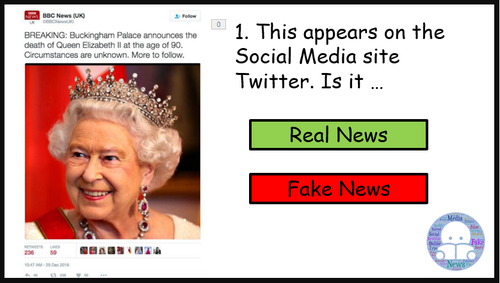







This is a whole lesson encouraging children to think critically and evaluate whether the information they see on the internet is real or fake.
This resource includes: lesson (or session) plan and an activity.
The plan details how to encourage children to think about what we use the internet for, and through the use of classroom clips introduces the idea of fake news. Children are given tips about how to evaluate whether a story etc might be fake or genuine.
The activity is to look at a screen shot of a news story/twitter feed/web page/email/viral photo and decide whether it is is real or fake.
Children click the answer each time (real or fake) -most are fake - and then there is extra information about how they might have reasoned this, what clues or warnings there were etc. These are mostly real-life examples.
Although the activity has been entitled ‘Fake News Spotter’, the scope of the lesson is actually much broader than ‘Fake News’ as it also touches upon scams, trusted sources of information and using the internet for research.
Tip: The activity is designed to be completed by the children individually/in pairs in ppt, but if that is not possible, it can be delivered as a whole class activity, or the slides can be printed and children can examine them in groups or pairs and sort them into a pile of ‘real’ or ‘fake’ before the answers are talked through as a whole class. This makes a nice reading-based activity in mixed ability pairs - perfect if there are carousels of activities taking places as part of a whole school approach to Safer Internet Day.
I’m really pleased with this lesson which I have used with Year 4. I did notice that, when using the ppt, they all were very keen simply to see if they were correct or incorrect and whizzed through the slides without really reading the important information, so I would advise that you put in place some incentives to ensure that they actually read the slides - perhaps partner has to ask a question based on the content, or each taking it in turns to read the slide aloud before moving on - I had to make at least one quarter of the class go back over it again when finished.
I hope you enjoy using this resource - there is so much misinformation out there, even for us adults - anything that helps our young people think more carefully about what they see or share, or how they select what sites they visit, is, in my view, a good thing!
Something went wrong, please try again later.
This resource hasn't been reviewed yet
To ensure quality for our reviews, only customers who have purchased this resource can review it
Report this resourceto let us know if it violates our terms and conditions.
Our customer service team will review your report and will be in touch.